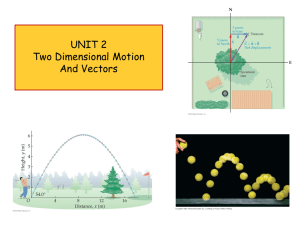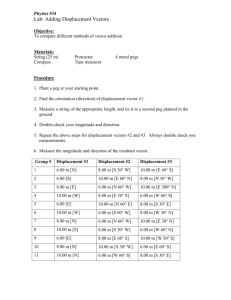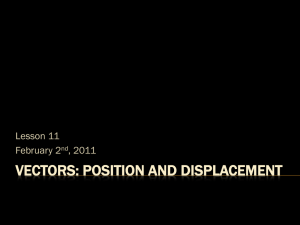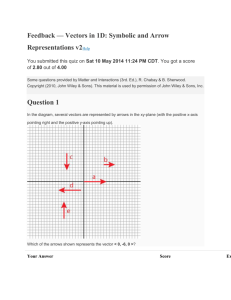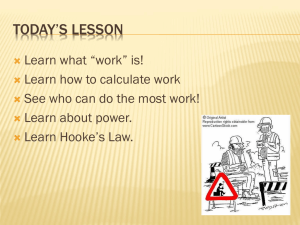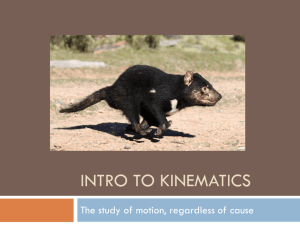Vector Lab
advertisement
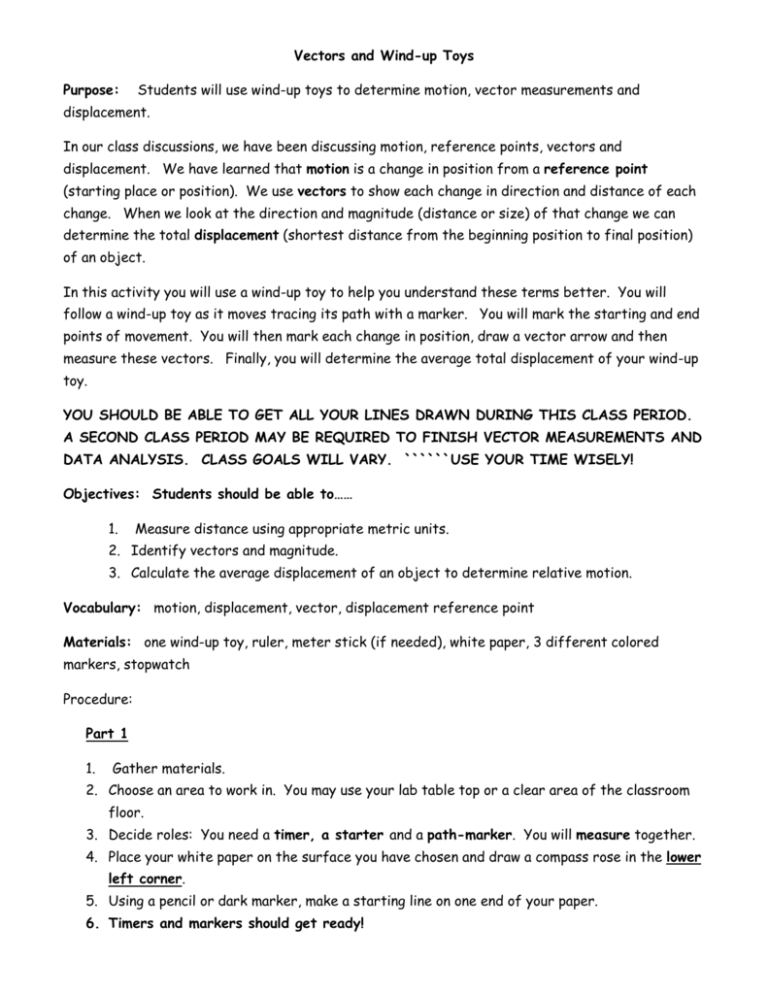
Vectors and Wind-up Toys Purpose: Students will use wind-up toys to determine motion, vector measurements and displacement. In our class discussions, we have been discussing motion, reference points, vectors and displacement. We have learned that motion is a change in position from a reference point (starting place or position). We use vectors to show each change in direction and distance of each change. When we look at the direction and magnitude (distance or size) of that change we can determine the total displacement (shortest distance from the beginning position to final position) of an object. In this activity you will use a wind-up toy to help you understand these terms better. You will follow a wind-up toy as it moves tracing its path with a marker. You will mark the starting and end points of movement. You will then mark each change in position, draw a vector arrow and then measure these vectors. Finally, you will determine the average total displacement of your wind-up toy. YOU SHOULD BE ABLE TO GET ALL YOUR LINES DRAWN DURING THIS CLASS PERIOD. A SECOND CLASS PERIOD MAY BE REQUIRED TO FINISH VECTOR MEASUREMENTS AND DATA ANALYSIS. CLASS GOALS WILL VARY. ``````USE YOUR TIME WISELY! Objectives: Students should be able to…… 1. Measure distance using appropriate metric units. 2. Identify vectors and magnitude. 3. Calculate the average displacement of an object to determine relative motion. Vocabulary: motion, displacement, vector, displacement reference point Materials: one wind-up toy, ruler, meter stick (if needed), white paper, 3 different colored markers, stopwatch Procedure: Part 1 1. Gather materials. 2. Choose an area to work in. You may use your lab table top or a clear area of the classroom floor. 3. Decide roles: You need a timer, a starter and a path-marker. You will measure together. 4. Place your white paper on the surface you have chosen and draw a compass rose in the lower left corner. 5. Using a pencil or dark marker, make a starting line on one end of your paper. 6. Timers and markers should get ready! 7. Wind up your toy. 8. Let your toy go on the starting line (your timer should start your stopwatch) and markers should follow it with a marker until it stops or runs off your paper. The stopwatch should be stopped at that time. Mark this endpoint with a dot. 9. Record your time in the data table provided. 10. Repeat steps 6-9 but use a different color for you second and third trial. Part 2-See diagram and do this for EACH line you drew 1. Look at each of the motion line you drew and make a mark at each place where the direction of your toy changed. 2. Using a ruler, draw an arrow at each section to show the direction of movement. 3. Measure each arrow in cm. 4. Record the distance and direction ON the arrow. This is a vector. 5. Count the number of vectors you made. Record this number in your data table. 6. Add up the total distance covered by your vectors. Record this in your data table. Part 3-do this for EACH line you drew 1. Using a meter stick or a ruler, draw a straight line from your starting point to your endpoint. 2. Measure the line you just drew in cm. Record this in your data table. Keep this page as a study tool in your notebook. Name__________________________________________Class_____Date________ Data Page-to be turned in. Data Table 1 Line color (mark below) Time (s)* # of Vectors Total Vector Distance Traveled Total Distance Traveled* Total Displacement AVERAGE *We will be using your time and distance measurement from this activity again at a later date. ANALYSIS: Use complete sentences. 1. What are your variables in this activity? a. Independent: b. Dependent: 2. What were your constants in this activity? 3. Are distance and displacement the same? Why or why not? 4. How can vectors be useful in describing motion? 5. Can you accurately predict the motion and displacement of your particular wind-up toy every time? Use your data to support your answer in a complete paragraph.

